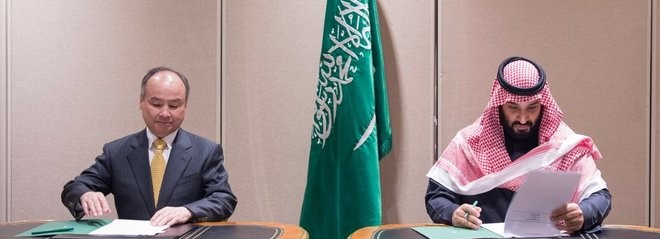Saudi Crown Prince Mohammed Bin Salman revealed on Tuesday a Memorandum of Understanding with Japanese group SoftBank to invest $200 billion dollars in the development of a 200 GW solar power plant in Saudi Arabia. You read it right, $200 billion, 200 GW. The announcement was given at a ceremony in New York with Softbank’s founder Masayoshi Son and is part of an ongoing effort by the Crown Prince to diversify the economy of the Oil Kingdom, the so called “Vision 2030″. It follows previous plans for a $50 billion investment in solar power announced just a year ago.
The project aims clearly at making Saudi Arabia a solar power exporter – rebalancing an economy overdependent on fossil fuels for exports and self consumption. This could mean some $40 billion in savings to power costs, it would also provide up to 100,000 jobs to the country, encompassing all related sectors from construction to panel manufacturing to power generation. Battery power storage also forms part of Saudis’ plan.
But how big is a project of this size? Well, no other solar power project in the world, announced or under construction, comes close. The closest are in fact not one but two orders of magnitude smaller at around 2 GW (although Adani Renewable Energy Park in Rajasthan, India promises 10 GW plants). The largest solar power station currently operational is the 1.5 GW Tengger Desert Solar Park in China, one of only three solar plants in the world to pass the 1 GW mark. In terms of geographical size, 200 GW might require an area of around 4,000 km2, a seemingly huge figure although negligible in absolute terms at 0.2% of Saudi Arabia’s total area of over 2 million km2.
To put Saudi Arabia’s latest ambition into perspective, the energy generated by this amount of solar power would be around 350 TWh per year or more at that latitude, comfortably covering all of the country’s current annual electricity demand (290 TWh), or that of a developed country such as the UK or Italy. 200 GW is also equivalent to what was the total cumulative capacity of solar power around the world only three years ago in 2015, which has since doubled to today’s 400 GW or so (pending 2017 installation data).
The scope for exporting renewable energy from Saudi deserts seems therefore natural and one wouldn’t be surprised if the target will be further increased in the future, of course depending on cost. That’s the fundamental aspect to consider in Saudis’ plan. At a projected 1$ per W or less – achieved through sheer economy of scale and good finance – and with the very generous levels of insulation that are typical of this country, solar electricity produced under this scheme would be bound to set new lows for solar electricity, a record already held by current Saudi solar project bids at less than 2¢/kWh. This is the main reason why, despite the unprecedented size and cost of this solar project, the plan looks credible and without doubt potentially very profitable.
“It’s a huge step in human history,” Prince Mohammed said. “It’s bold, risky and we hope we succeed doing that”. Many are the plans for gigantic energy infrastructure that have been made internationally over the years and not been carried out to completion, most notably in nuclear power, with its delays and snowballing costs. Yet even today, Saudi Arabia is separately planning construction of 16 nuclear reactors to increase and diversify its electricity production alongside renewables.
The country’s timing and choice of technologies may this time make the difference between failure and success. Its ambitious solar vision follows in the footsteps of a growing number of large wind and solar projects being completed around the world today. Between this and the 16 nuclear plants, I know where I’d put my money. With installation of the first solar panels slated to start as early as this year, we shall soon have a good idea.







